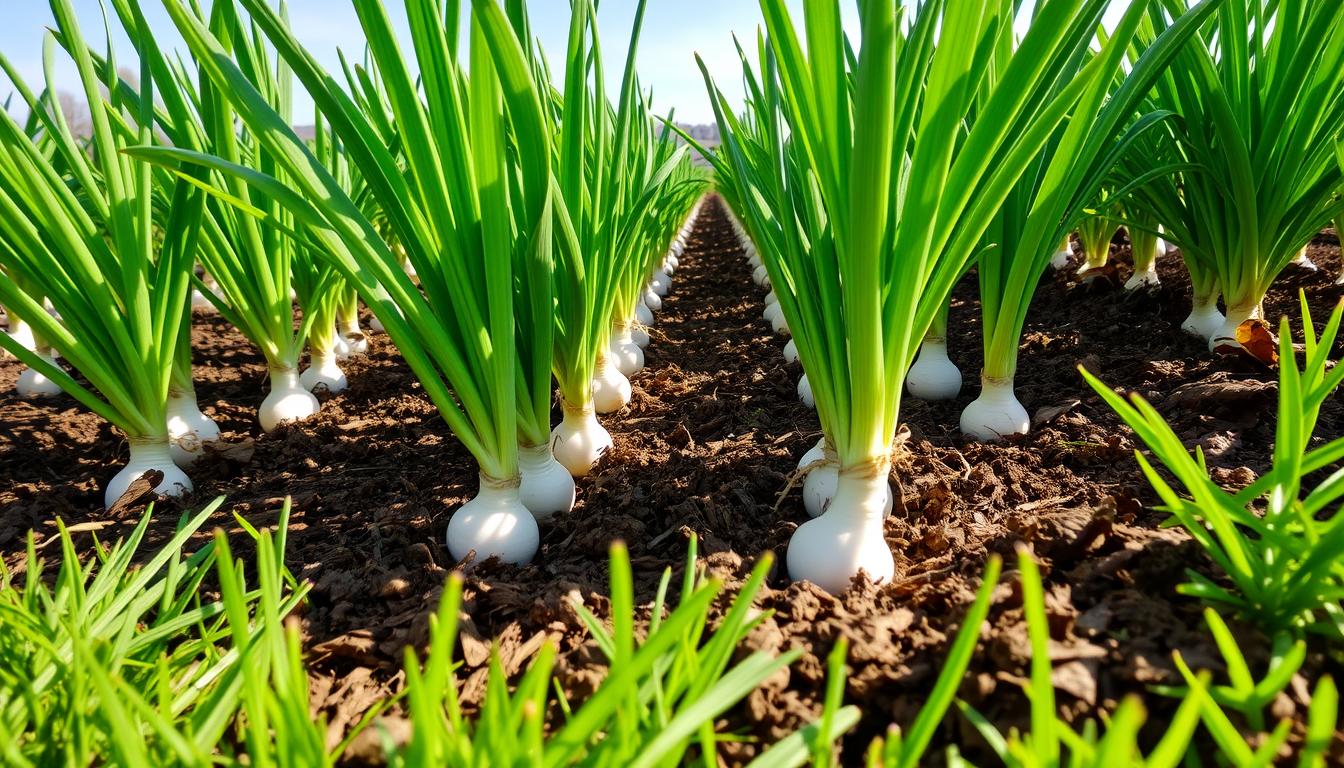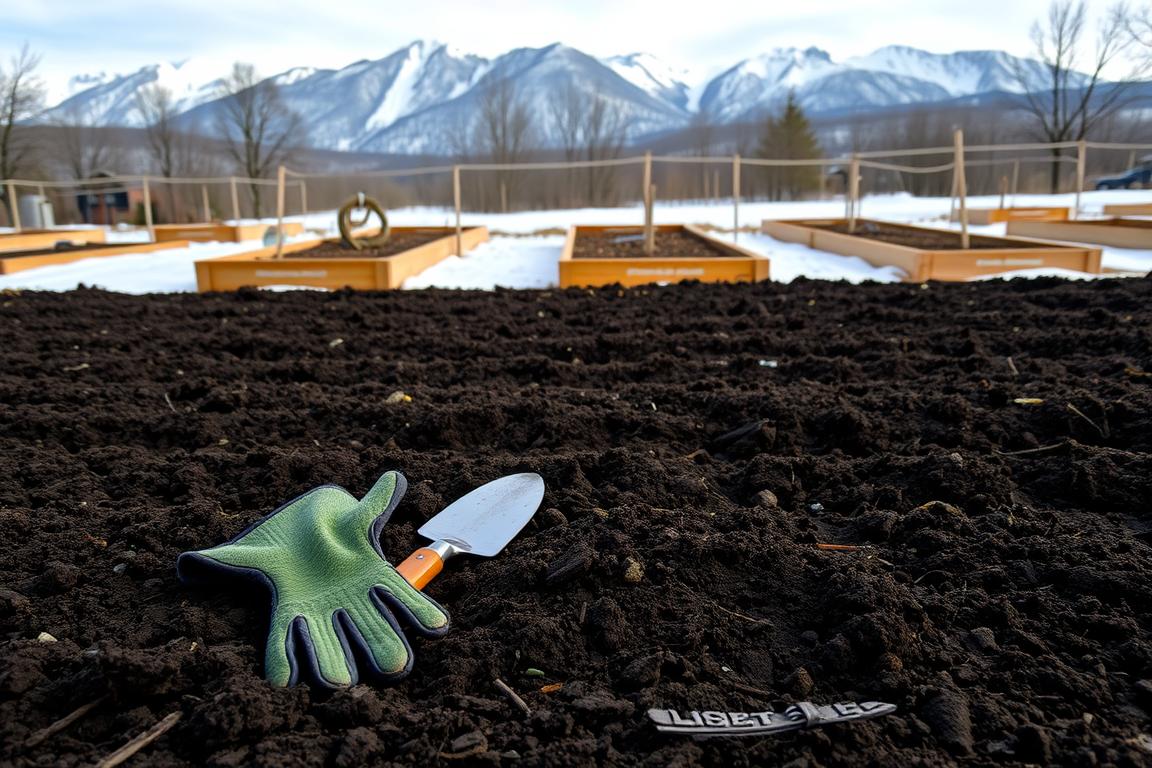As a passionate gardener, I know onions are essential for any home garden. They grow well in small spaces and can be stored for months. But, growing great onions requires some key tips for beginners. In this guide, I’ll share the basics of planting, growing, and harvesting onions for success.
Key Takeaways
- Onions can be grown from sets, transplants, or seeds, each with their own advantages
- Proper soil preparation and consistent watering are crucial for healthy onion growth
- Onions come in a variety of types, including short-day, long-day, and day-neutral
- Timing the harvest correctly is key to ensuring a bountiful crop that can be stored for months
- Proper curing and storage techniques can help extend the shelf life of your onions
Introduction to Growing Onions
Onions are a great addition to any garden. They add flavor to many dishes, from sauces to roasted onions. Growing onions is simple, as they need little space and care. Knowing the types of onions and their benefits is key.
Why Grow Onions?
Onions are full of nutrients and antioxidants, offering health benefits. They’re also versatile in cooking, enhancing many recipes. Plus, onions are easy to grow and fit well in small spaces.
Types of Onions
There are different types of onions to grow. The main types are:
- Short-day onions, needing 10-12 hours of daylight, best for southern areas.
- Long-day onions, requiring 14+ hours of daylight, ideal for northern climates.
- Day-neutral onions, growing in various daylight hours, adaptable to many regions.
Knowing the needs of each type helps choose the right ones for your garden. This ensures a good onion harvest.
Onions are a staple in my kitchen, and growing them in my garden has been incredibly rewarding. The fresh, homegrown flavor is unbeatable.”
Choosing the Right Onion Variety
Choosing the right onion variety is key to growing success. Onions are classified by their day-length needs, which vary by region. Knowing this helps pick the best onions for your area.
Short-Day Onion Varieties
Short-day onions grow well in the south with 10-12 hours of daylight. Varieties like ‘Bermuda’ and ‘Creole’ start bulbing early in spring. They’re perfect for USDA zones 7-10.
Long-Day Onion Varieties
Long-day onions prefer the north with 14-16 hours of daylight. ‘Walla Walla’ and ‘Yellow Granex’ are good examples. They start bulbing in summer, ideal for USDA zones 4-6.
Day-Neutral Onion Varieties
Day-neutral onions work best in middle latitudes with 12-14 hours of daylight. ‘Sweet Sandwich’ and ‘Candy’ are examples. They’re less picky about day length, growing well in a wider range.
Choosing the right onion variety for your region is crucial for a good harvest. Knowing the day-length needs of different onions ensures success in your garden.

| Onion Variety | Daylight Requirements | Suitable Regions |
|---|---|---|
| Short-Day Onions | 10-12 hours | Southern regions (USDA zones 7-10) |
| Long-Day Onions | 14-16 hours | Northern regions (USDA zones 4-6) |
| Day-Neutral Onions | 12-14 hours | Middle latitudes |
Planting and Growing Onions
Onions add flavor and variety to any garden. They need the right soil, planting, and care to grow well. This ensures a good harvest.
Preparing the Soil
Onions love full sun and well-draining soil. Before planting, add compost or aged manure to make the soil better. The soil should be slightly acidic, with a pH of 6.2 to 6.8.
Planting Onion Sets or Transplants
You can plant onion sets or start from seed. Sets are quick and easy, while seeds are best for greenhouses. Plant sets or transplants 4-6 inches apart, 1-2 inches deep.
Watering and Fertilizing Onions
Onions need regular fertilizer, especially nitrogen. Stop fertilizing when they start to form bulbs. Keep the soil moist but not too wet, as onions don’t like too much water.
| Onion Growing Requirement | Recommendation |
|---|---|
| Soil Preparation | Amend with compost or aged manure, aim for a pH between 6.2 and 6.8 |
| Planting | Space sets or transplants 4-6 inches apart in rows 12-18 inches apart, bury 1-2 inches deep |
| Watering | Keep soil consistently moist, but avoid overwatering |
| Fertilizing | Use a nitrogen-rich fertilizer, stop when bulbing process begins |
Follow these tips for soil preparation for onions, planting onion sets, planting onion transplants, watering onions, and fertilizing onions. You’ll have a great onion growing season.
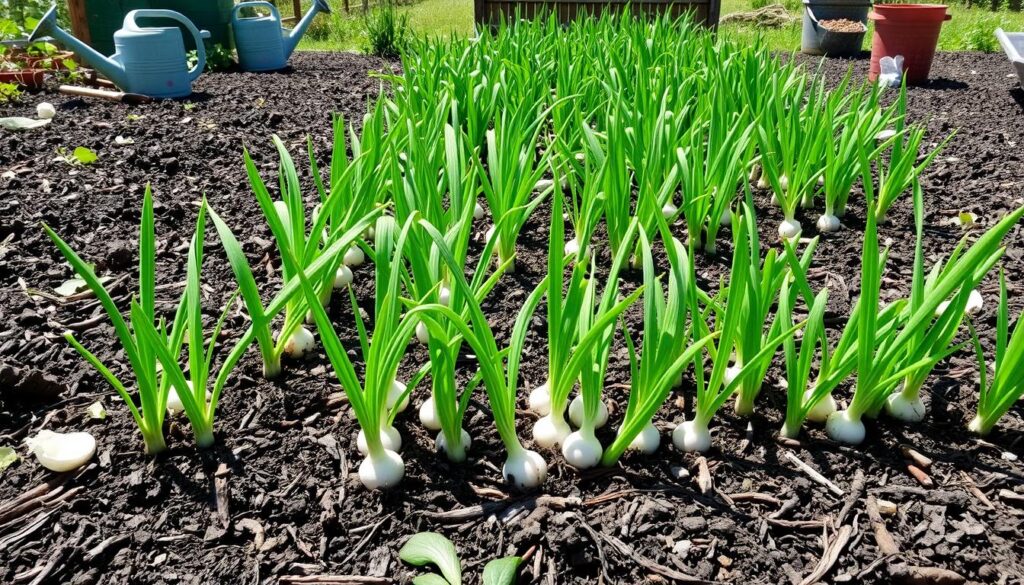
The Basics of Growing Onions: A Beginner's Guide
Growing onions is rewarding for any gardener, new or experienced. They are versatile and essential in cooking. Here, we’ll cover the basics to grow onions successfully.
Choosing the right onion variety is crucial. Onions fall into three types: short-day, long-day, and day-neutral. Short-day onions bulb when daylight is 10 to 12 hours. Long-day onions need 14 to 16 hours. Day-neutral onions bulb in 12 to 14 hours. Pick the right type for your area for the best results.
Soil preparation is key. Onions love well-drained, rich soil with compost or aged manure. The soil should be slightly acidic, between 6.0 and 6.8. Plant onion sets or transplants 1 inch deep and 4-6 inches apart for best growth.
Onions need consistent moisture and regular fertilizing. They need about 1 inch of water weekly and benefit from nitrogen-rich fertilizers every 2-3 weeks after planting. Stop fertilizing when they start to bulb to help them grow bigger.
With proper care, you’ll get a big onion harvest. Onions are ready when their foliage yellows and falls over, usually in mid to late summer. After curing, store them in a cool, dry place for long-term use.
“Onions are a veg-plot favorite, being one of the easiest crops to grow, taking up little space, and providing reliable harvests for various dishes.”
By following these basic steps, you’ll grow a thriving onion crop. Enjoy the flavorful rewards of your homegrown onions.
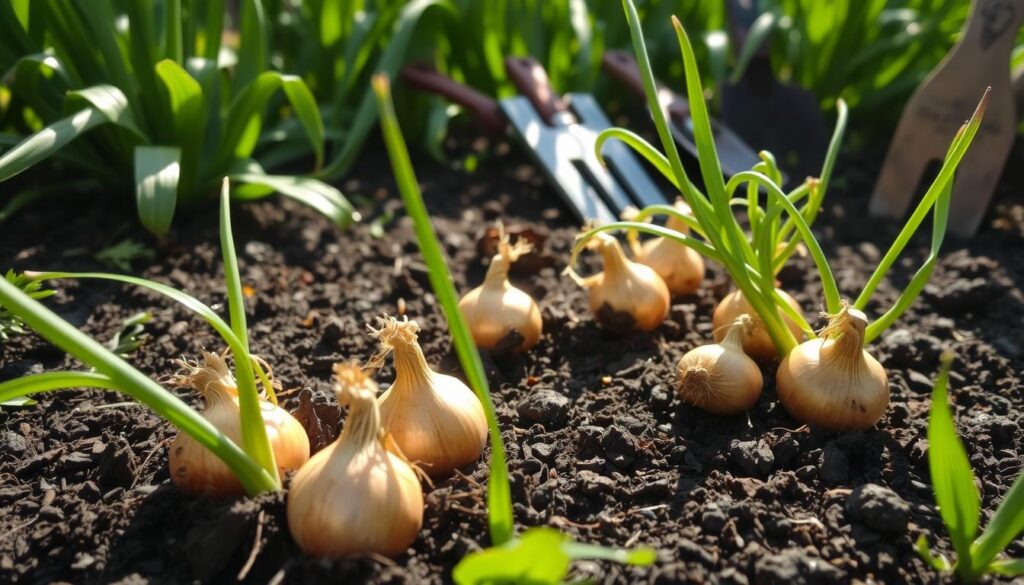
Troubleshooting Common Onion Problems
Growing onions can be very rewarding. But, they can face pests and diseases. I’ve had my share of onion troubles and I’m here to help. I’ll share tips for pest control and disease management.
Dealing with Pests and Diseases
One big problem I’ve seen is onion thrips. These tiny insects harm the leaves by sucking sap. This makes the leaves turn gray and wilt, slowing down onion growth. Using the right insecticide can help fight this.
Fungal diseases like white rot, rust, and downy mildew are also common. They can turn leaves brown. Keeping the soil healthy and using fungicides can prevent and treat these onion issues.
It’s crucial to check your onions often for pests or diseases. Fixing these common onion problems quickly can lead to a healthy harvest.
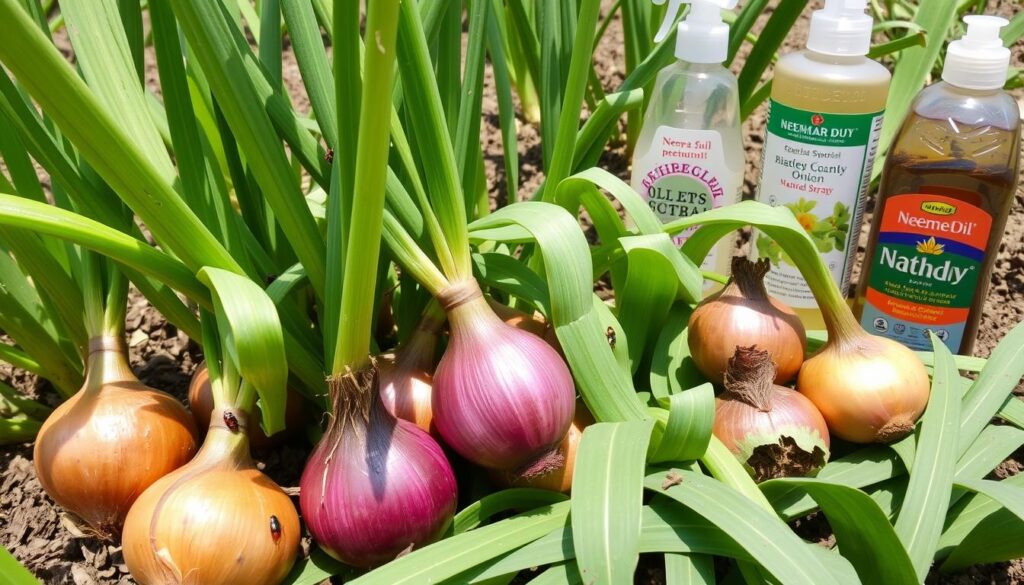
“Troubleshooting onion issues is all about staying proactive and addressing problems before they get out of hand. With the right pest control and disease management strategies, you can keep your onion crop thriving.”
Conclusion
Growing your own onions at home is rewarding and practical. It’s a great addition to any home vegetable garden. By choosing the right onion variety and preparing the soil, you can enjoy a big harvest. Onions are easy to care for and can be a reliable crop for gardeners.
Onions grow in many places, from the tropics to cold areas. Knowing the different onion growing tips helps you pick the best type for your area. Whether it’s short-day, long-day, or day-neutral, there’s an onion for almost every climate.
Starting with seeds or transplants is key. Make sure the soil is ready, provide the right nutrients, and water and care for them properly. With the right steps, you can solve common problems and have a great harvest every year. So, why not try growing your own onions and enjoy their flavor at home?
FAQ
Q: What are the main types of onions to consider?
A: There are three main types of onions: short-day, long-day, and day-neutral. Each type grows best in different places based on how far north or south you are and how many daylight hours you get.
Q: How do I choose the right onion variety for my growing region?
A: To pick the right onion, think about where you live and how much daylight you get. Short-day onions do well in the south with 10-12 hours of sun. Day-neutral onions like the middle latitudes with 12-14 hours. Long-day onions prefer the north with 14-16 hours of sun.
Q: What soil requirements do onions have?
A: Onions need lots of sunlight and soil that drains well and is rich in nutrients. Before planting, add compost or aged manure to the soil.
Q: How do I plant onions?
A: You can plant onions as sets (small bulbs) or transplants. Plant them 4-6 inches apart in rows 12-18 inches apart. Make sure to bury them 1-2 inches deep.
Q: How do I care for my onion plants?
A: Onions need a lot of food, so fertilize them often with a fertilizer high in nitrogen. Stop fertilizing when they start to form bulbs. Keep the soil moist but don’t overwater.
Q: What are some common problems with growing onions?
A: Problems include onion thrips and fungal diseases like white rot, rust, and downy mildew. Use the right insecticides or fungicides. Also, make sure to space them right and keep the soil healthy.


